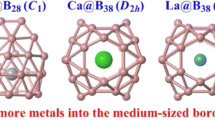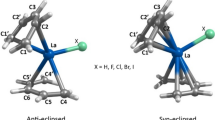Abstract
The ability to efficiently and accurately predict solid-state geometries of lanthanide coordination compounds efficiently and accurately is central for the design of new ligands capable of forming stable and highly luminescent complexes. Accordingly, we present in this paper a report on the capability of various ab initio effective core potential calculations in reproducing the coordination polyhedron geometries of lanthanide complexes. Starting with all combinations of HF, B3LYP and MP2(Full) with STO-3G, 3-21G, 6-31G, 6-31G* and 6-31+G basis sets for [Eu(H2O)9]3+ and closing with more manageable calculations for the larger complexes, we computed the fully predicted ab initio geometries for a total of 80 calculations on 52 complexes of Sm(III), Eu(III), Gd(III), Tb(III), Dy(III), Ho(III), Er(III) and Tm(III), the largest containing 164 atoms. Our results indicate that RHF/STO-3G/ECP appears to be the most efficient model chemistry in terms of coordination polyhedron crystallographic geometry predictions from isolated lanthanide complex ion calculations. Moreover, both augmenting the basis set and/or including electron correlation generally enlarged the deviations and aggravated the quality of the predicted coordination polyhedron crystallographic geometry. Our results further indicate that Cosentino et al.’s suggestion of using RHF/3-21G/ECP geometries appears to be indeed a more robust, but not necessarily, more accurate recommendation to be adopted for the general lanthanide complex case.

Graphical visualization of unsigned mean errors, UME(Eu-L)s, involving only the interatomic distances between the europium central ion and the oxygen atoms of the coordination polyhedron of the cation nona-aqua-europium(III) for various model chemistries, all compared to the “Cambridge Structural Database 2004” crystallographic geometry






















Similar content being viewed by others
References
Lehn J-M (1990) Angew Chem Int Ed Engl 29:1304–1309
Kido J, Okamoto Y (2002) Chem Rev 102:2357–2368
Malta OL (1982) Chem Phys Lett 87:27–29
Malta OL (1982) Chem Phys Lett 88:353–356
de Sa GF, Malta OL, Donega CD, Simas AM, Longo RL, Santa-Cruz PA, da Silva EF (2000) Coord Chem Rev 196:165–195
Faustino WM, Rocha GB, Gonçalves e Silva FR, Malta OL, de Sá GF, Simas AM (2000) J Mol Struct (THEOCHEM) 527:245–251
Dolg M (2000) Modern methods and algorithms of quantum chemistry, vol. 1. In: Grotendorst J (ed) John von Neumann Institute for Computing, Jülich, NIC Series, pp 479–508
Cundari TR, Stevens WJ (1993) Chem Phys 98:5555–5565
Freire RO, Rocha GB, Simas AM (2005) Inorg Chem 44:3299–3310
de Andrade AVM, da Costa Jr NB, Simas AM, de Sá GF (1994) Chem Phys Lett 227:349–353
Rocha GB, Freire RO, Júnior NBC, de Sá GF, Simas AM (2004) Inorg Chem 43:2346–2354
Wang DQ, Zhao CY, Phillips DL (2004) Organometallics 23:1953–1960
Hay PJ (2003) Faraday Discuss 124:69–83
Vazquez J, Bo C, Poblet JM, de Pablo J, Bruno J (2003) Inorg Chem 42:6136–6141
Joubert L, Maldivi P (2001) J Phys Chem A 105:9068–9076
Bolvin H, Wahlgren U, Moll H, Reich T, Geipel G, Fanghanel T, Grenthe I (2001) J Phys Chem A 105:11441–11445
Maron L, Eisenstein O (2000) J Phys Chem A 104:7140–7143
Hay PJ, Martin RL (1998) J Chem Phys 109:3875–3881
Dolg M, Stoll H, Savin A, Preuss H (1989) Theor Chim Acta 75:173–194
Frisch MJ, Trucks GW, Schlegel HB, Scuseria GE, Robb MA, Cheeseman JR, Zakrzewski VG, Montgomery JA Jr, Stratmann RE, Burant JC, Dapprich S, Millam JM, Daniels AD, Kudin KN, Strain MC, Farkas O, Tomasi J, Barone V, Cossi M, Cammi R, Mennucci B, Pomelli C, Adamo C, Clifford S, Ochterski J, Petersson GA, Ayala PY, Cui Q, Morokuma K, Malick DK, Rabuck AD, Raghavachari K, Foresman JB, Cioslowski J, Ortiz JV, Stefanov BB, Liu G, Liashenko A, Piskorz P, Komaromi I, Gomperts R, Martin RL, Fox DJ, Keith T, Al-Laham MA, Peng CY, Nanayakkara A, Gonzalez C, Challacombe M, Gill PMW, Johnson BG, Chen W, Wong MW, Andres JL, Head-Gordon M, Replogle ES, Pople JA (1998) Gaussian 98, Revision A.7. Gaussian Inc., Pittsburgh, PA
Villa A, Cosentino U, Pitea D (2000) J Phys Chem A 104:3421–3429
Cosentino U, Villa A, Pitea D, Moro G, Barone V, Maiocchi A (2002) J Am Chem Soc 124:4901–4909
Cosentino U, Pitea D, Moro G, Barone V, Villa A, Muller RN, Botteman F (2004) Theor Chem Acc 111:204–209
Mohamed-Ibrahim MI, Chee SS, Buntine MA, Cox MJ, Tiekink ERT (2000) Organometallics 19:5410–5415
Chen DL, Lai CS, Tiekink ERT (2003) Zeitschrift fur Kristallographie 218:747–752
Allen FH (2002) Acta Crystallogr B 58:380–388
Bruno IJ, Cole JC, Edgington PR, Kessler M, Macrae CF, McCabe P, Pearson J, Taylor R (2002) Acta Crystallogr B 58:389–397
Allen FH, Motherwell WDS (2002) Acta Crystallogr B 58:407–422
Chatterjee A, Maslen EN, Watson KJ (1988) Acta Crystallogr Sect B: Struct Sci 44:381–386
Cosentino U, Moro G, Pitea D, Calabi L, Maiocchi A (1997) J Mol Struct (THEOCHEM) 392:75–85
Acknowledgements
We appreciate the financial support from CNPq, CAPES (Brazilian agencies), and Grants from Instituto do Milênio de Materiais Complexos, FACEPE (Programa Primeiros Projetos) and Construção do Conhecimento por Agrupamento de Dados (CoCADa). We also wish to thank CENAPAD (Centro Nacional de Processamento de Alto Desempenho) at Campinas, Brazil, for having made available to us their computational facilities Finally, we gratefully acknowledge the Cambridge Crystallographic Data Centre for the Cambridge Structural Database.
Author information
Authors and Affiliations
Corresponding author
Rights and permissions
About this article
Cite this article
Freire, R.O., Rocha, G.B. & Simas, A.M. Lanthanide complex coordination polyhedron geometry prediction accuracies of ab initio effective core potential calculations. J Mol Model 12, 373–389 (2006). https://doi.org/10.1007/s00894-005-0027-5
Received:
Accepted:
Published:
Issue Date:
DOI: https://doi.org/10.1007/s00894-005-0027-5




